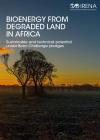

-
-
IRENA (2017), Bioenergy from degraded land in Africa: Sustainable and technical potential under Bonn Challenge pledges, International Renewable Energy Agency, Abu Dhabi.
Copied
/-/media/Files/IRENA/Agency/Publication/2017/Dec/IRENA_Bioenergy_Africa_degraded_land_2017.pdf
Copied
Bioenergy from degraded land in Africa
Newsletter
Restoration of degraded land can create vast bioenergy crop potential, without constraining food crops or other land use options. This presents an important opportunity for African countries to develop modern, sustainable bioenergy from rapidly growing wood crops at the same time as pursuing ambitious forest landscape restoration initiatives.
This study from the International Renewable Energy Agency (IRENA) presents a methodology to estimate the sustainable energy potential from land restoration in line with the Bonn Challenge, particularly as it relates to African countries. The Bonn Challenge is a global effort to bring 150 million hectares of the world’s deforested and degraded land into restoration by 2020, and 350 million hectares by 2030.
The African Forest Landscape Restoration initiative, AFR100, has set out to collect pledges to restore 100 million hectares of degraded land, mostly in in sub-Saharan Africa. To date, 18 countries have pledged to restore 75 million hectares.
If all this land were devoted to bioenergy crops, it could yield some 6 exajoules (EJ) per year of primary bioenergy, the study finds. Further investigation could clarify which lands – the most productive or the most degraded – should be dedicated to bioenergy crops, both to attain the best yields and to meet other economic, social and environmental needs. In either case, however, bioenergy can strengthen the economic incentive to undertake restoration efforts.
The report includes more detailed country-level analyses for Rwanda and Kenya, which have applied a Resource Opportunities Assessment Methodology (ROAM) to evaluate their restoration options. Rwanda’s bioenergy potential could reach 45 petajoules (PJ) per year on 1.4 million hectares, while Kenya’s could reach 28 PJ per year on 2.2 million hectares.
Country-level studies are required to assess different uses of degraded land, such as energy and food production, as well as nature conservation, and find possible synergies among these uses. Agroforestry, for example, can produce a high-yielding mix of food and fuel crops while enhancing biodiversity.



